Architecture In the Age of Now
Repetition, recurrence, and fractal patterning look like eternity. Cultures that provide them will win over rootless people
For a long time, Boston was a truly beautiful city. Its architectural aesthetic was instantly recognizable: stately brick townhouses with green patina copper bay windows, rich detailing, and wrought-iron balconies; ornate churches by architectural luminaries like Henry Hobson Richardson; working-class triple-deckers with their humble repetition of forms and elegant decks. A morning view down a residential Boston street, tripled rows of wooden balustrades basking in the slanting light, is still one of New England’s best hidden treats.
But over the past decade, Boston has fallen ill with a grave case of the Architecture of Right Now. Featureless glass — or even worse, plastic-cladded — high-rises in a minimalist or deconstructive style have been steadily replacing or crowding out beloved older buildings. As the new structures, which overwhelmingly lack traditional architectural elements or ornamentation, ooze across more of what used to be a defiantly unique cityscape, the overall effect is like that of being conquered by especially tasteless barbarians.

The Architecture of Right Now perfectly exemplifies the neoliberal aesthetics of “flatness.” But this flatness expresses an underlying utopian ideology whose emphasis on linear progress fundamentally clashes with basic human psychological needs for continuity, repetition, and organicity. It’s an inherently uprooting movement. Relentlessly rejecting older forms, the Right Now School insists concretely (pun intended) that human society must move only forward, rationally conquering, never repeating what came before. It’s asking us to give up the very idea of home.
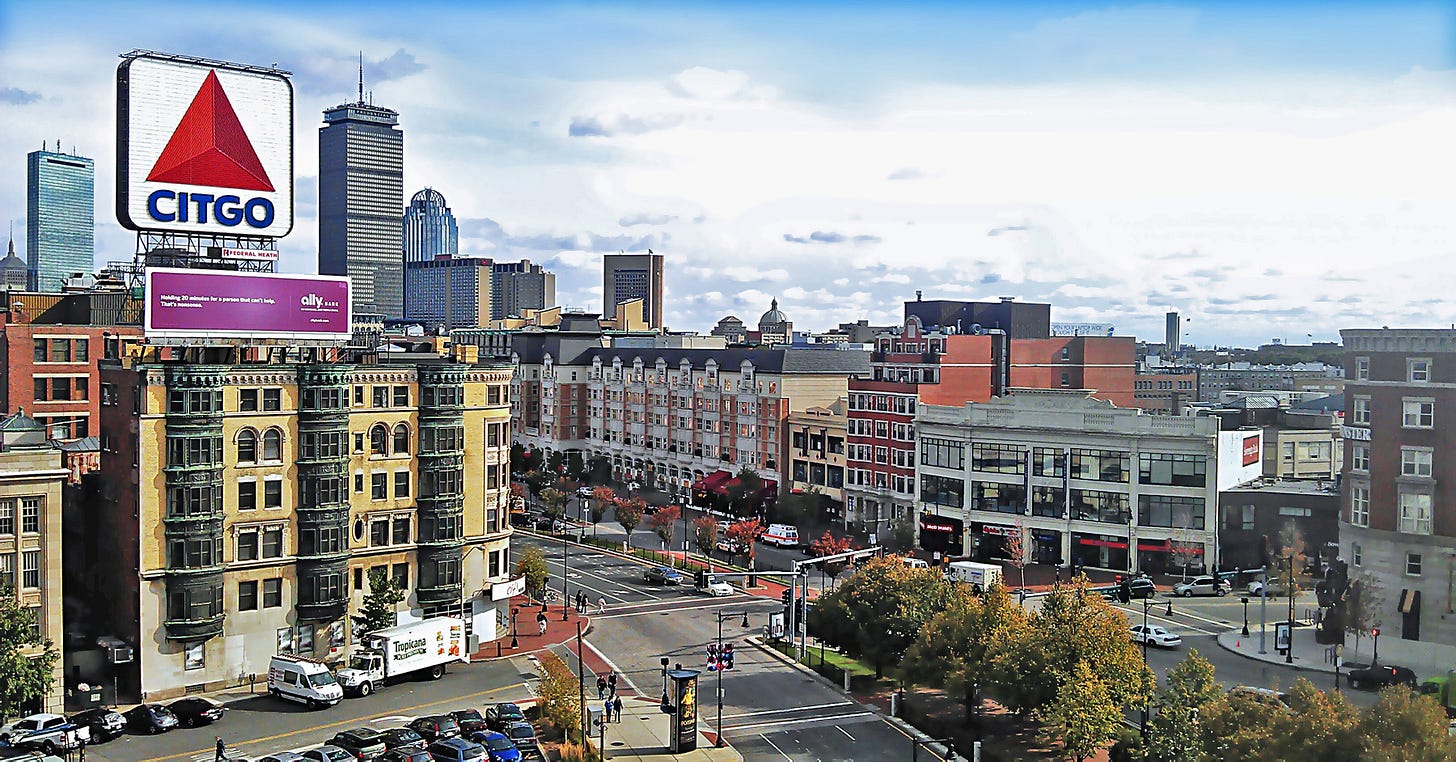

But there’s a problem: this isn’t how life works. I mean that literally, biologically. All living beings, including us humans, are inherently looping feedback systems. Biological organisms comprise self-balancing feedback circuits that work in concert to keep key values — body temperature, glucose levels, motivational states, reproductive output, you name it — within viable bounds. Biological systems that go linear aren’t biological systems anymore. They’re dead. If we analogize culture and society with biological life (something that many of my academic colleagues and mentors in the evolutionary human sciences are quite happy to do), the Architecture of Right Now begins to look less like a tasteless mistake and more like a grotesque kind of thanatos: the Freudian urge toward death.
Loops in Art and Life
The foundation of life in looping, organic processes may be part of the reason why we find natural scenes so relaxing and soothing. Yellowstone gets millions of tourist visitors per year, but very few willingly pay to visit, say, old Soviet tower blocks. The late evolutionary biologist E.O. Wilson called the human attraction to natural surroundings “biophilia.” Biophilia implies a preference for self-similarity or fractal forms whose structures repeat themselves across scales, as in the trunk, limbs, branches, twigs, and finally veins in the leaves of trees. We humans like fractal patterns so much that observing them alleviates physiological stress and even reduces fatigue.
Perhaps not coincidentally, older, traditional building styles, such as Gothic churches and medieval mosques, were chock-full of fractal patterns. By comparison, modern urban streetscapes emphasize (variously) clean lines, empty spaces, sweeping curves. Deconstructivist buildings break apart shapes and lines in order to challenge traditional ideas of form. That is, few modern or postmodern buildings use the natural patterns our perceptual systems are optimized for.
An interesting consequence of this anti-biophilic construction style is that modern buildings are actually harder for the brain to perceive. One team of cognitive scientists and physicists mathematically analyzed different kinds of building façades — both traditional and modern — then used eye-tracking simulation software to map how human observers would process the scenes. They found that
Fractal patterns impact human visual perception and processing…While traditional urban objects such as doors, signs, windows, and stairs can be recognized rapidly, non-traditional designs simply do not register. As far as the brain is concerned, the typically undistinguished glass front door to a modernist building is simply not there.
The researchers concluded that we urgently need to change the way we build by re-incorporating older design styles that made use of repeating fractal patterns and ornamentation. From a neurobiological perspective, the move from older to modern architecture was “a huge mistake.”
The Centrality of Leisure
But this post isn’t actually about architecture. It’s about the deeper cultural logic of this biological need for repetition and organicity, which in human behavior manifests as something quite alien to modern and postmodern ideologies. I’m talking about sacrifice.
The Architects of Right Now are fundamentally anti-sacrificial. Their rejection of ornamentation, especially the traditional kind, is explicit and principled; at the very beginning of the 20th century, the architectural theorist Adolph Loos even called useless ornamentation a “crime.”
But all ornamentation is useless. No building needs dentil cornices or bas relief designs or pediments to stand up and keep the rain out. Spending money on such things is always, in some sense, an impractical extravagance.
Yet impractical extravagances are exactly what make cultural products valuable. The philosopher Josef Pieper argued that human culture wasn’t rooted in utility or efficiency (somewhat ironically, given that he was, er, German), but in leisure — that is, in the superfluous or unnecessary spirit of play. A public square with a fountain and sculptures isn’t economically productive. A big urban church inconveniently takes up valuable land that could otherwise be used for, say, overpriced condos. But it was around such “useless” spaces that most traditional neighborhoods and cities organically grew up. And people treasured them. Still do, in fact, as the hordes of tourists gawping around every historic European city center each August can attest. The very uselessness of these squares and churches somehow created an enduring value that continues to attract people in droves centuries later.
By contrast, postwar residential and commercial neighborhoods in North America, which tend to lack central, sanctified, ornamental gathering spaces, famously don’t quite feel like communities. Lacking impractical and ceremonial cores, they wind up seeming entirely oriented toward private acquisition and consumption — that is, toward utility.
Pitting treasured European city centers against American suburbs — today’s practical, humdrum living spaces — might seem like an unfair comparison. But the towns and squares that tourists flock to visit in Europe were the practical living spaces of centuries past, and many medieval rural French villages look like miniature Dantean visions of heaven. Practicality and beauty don’t have to be opposed. Throughout history, they’ve usually been enmeshed.

So it wasn’t coincidence that the buildings and structures that once anchored central gathering places in Western cities, even in little lower-tier villages and towns, tended to be lush with decoration and ornamentation. (In most of the world, they still are!) Public buildings, rotundas, and houses of worship all boasted unnecessary flourishes like fluted columns or pilasters with capitals, pedimental sculptures, patterned tympanums, fountain phiales, you name it. Most of these elements were characterized by — surprise! — repetition, even redundancy. The floral bas reliefs in a frieze repeated themselves ad infinitum around a wall. The fluting around a column was a form of repeated pattern that, circling around itself, never terminated.
Sacrifice
Here’s an interesting fact: the architectural ornamentation of ancient Greece, which is where we get most of the classic forms that we don’t use, probably originally reflected the sacrifice in Greek religion. For example, columns were designed to resemble trees, which were the original locations of sacrificial cults. There’s a deep logic here. Like ornamentation, religious sacrifice is usually repetitive and cyclical, as in the elaborate ancient Israelite system of daily and annual sacrifice, whose most serious sacrifices required participants to slaughter and burn an entire healthy bull to ashes on the altar at the temple in Jerusalem.
That sounds wasteful (and disgusting) to modern ears. But the temple sacrifice expressed the central place that leisure — that is, uselessness — occupied for the Israelites. A bull was a useful and valuable possession, a stud for producing more cattle, a maintainer of dairy herds. To kill and burn one at the altar meant that the participants really didn’t see profit or utility as the most important things in life. To repeat this sacrifice every month (and en masse each year at Sukkoth, the Feast of Booths) was to signal without ambiguity that something else, something sacred, was more valuable than practicality for the entire nation.
We don’t sacrifice animals anymore in most historically Christian countries. But in a real sense, churches and public squares are still sacrifices. Once you invest funds on elaborate ornamentation for a building or public space, the money isn’t yours anymore. You can’t use it for investment or lending. What you reap in return isn’t financial profit, but a space that, in its very form and shape, evokes permanence and nourishes the biophilic need for repetition, cyclicality, and leisure.
So we arrive at an interesting set of connections: nonfunctional ornamentation is a kind of sacrifice, because it costs resources and time without producing immediate economic returns. Ornamentation and sacrifice are also often, even generally, repetitive and patterned, both concretely (as in the visible repetition of shapes in filigree) and historically (as in the continual re-use of classic forms, patterns, and rituals). Psychologically, recurrent patterning is calming, particularly when it’s structured fractally.
Iconically, patterns don’t evoke linear progress and forward momentum the way that clean lines do; instead, they look like continuity and recurrence. By filling spaces with repeated form, traditional spaces also suggest that future possibilities are constrained, that there are conventional bounds on what we’ll do next. By contrast, the design aesthetic of, say, tech offices — blank white walls, sleek glass — says “make everything new.” It’s a blank slate. Literally.
Homeostasis Versus Linearity
Ultimately, by placing recurring bounds on possibility, biophilic patterning — both in architecture and in life — represents stability. Let me explain what I mean.
Homeostasis, or more accurately dynamic equilibrium, entails the cyclical revisiting of set states in an organism. We maintain our physiological order when our core temperature orbits 98.6 degrees Fahrenheit, now getting a little hotter, now a little cooler, but always roughly anchored at the stable set point. Constantly attaining a “new” temperature, trending linearly in one direction, is extremely suboptimal, as engineers would put it. A body that’s uniformly cooling or warming is having (or is about to have) a very, very bad day.
To be alive, then, means to maintain dynamic equilibrium around core, non-negotiable variables using self-corrective feedback loops — inhalation and exhalation, temperature regulation, circadian and even menstrual cycles. Feedback loops. Not arrows! The interactions of our different homeostatic cycles over time create repeatable, interweaving patterns. Plot them together in one combined graph, and you’d get beautiful renderings of sine waves embedded in sine waves, a repetitive, fractal interweaving that resembles the patterns of filigree in old-fashioned balconies or mantelpieces far more than it does the sleek linearity of a tech office or a neofuturist office block.
In other words, cultural patterning, whether in an architectural ornament or jewelry or in the repetition of daily or weekly rituals and assemblies, structurally looks more like dynamic equilibrium than like linearity. It cyclically revisits set points at regular or semi-regular intervals over time and space. As a result, it tends to encourage psychological and cultural resilience across scales. As one group of researchers writes, “Repetition is central to the very nature of ornament.…ornament repeats, and through this repetition, imposes order on the cosmos.”
What Modernity Is
All of this talk of patterning and recurrence sounds suspicious, even reactionary, to modern ears. Aren’t we supposed to be overcoming the past, always forging brand-new directions? Isn’t history something to escape from? Well, that’s certainly what we’re supposed to believe. The very etymology of the word “modern” stems from the Latin modo, meaning “just now.” In German, the word Mode (which comes from the same root) just means “fashion.” The cutting-edge duds of a trendy Berliner (not that there’s any other kind) are modisch in the local patois, and we Americans call apple pie with ice cream à la mode because, when it was invented in the late 1800s, this then-new combination was “the fashion” among cutting-edge restaurateurs.
What I’m getting at is that, etymologically, the very concept of “modernity” is shot right through with connotations of newness, of constant updating and change. Looping, fractal recurrence is the furthest thing from modern consciousness. It shouldn’t surprise us that the “modern” historical era, which conventionally began around A.D. 1500, has always celebrated progress, updating, improvement, and reform above everything else. Modernity divides time into the past and brand-new, and it always prefers the brand-new. It’s inherently linear.
But this fixation on newness and linear progress also helps explain why modernity has been so chronically, explosively unstable: human societies are, in a way, complex (adaptive) systems. As such, they’re sustained by homeostasis, not linear change. In organic systems, nested hierarchies of loops offer buffering through redundancy. If lack of glucose in your bloodstream fails to trigger a hunger signal, the regular (cyclical) pattern of eating at certain times each day should fill the gap. If your weekly game of cards with the neighbors peters out and you lose touch with each other, then the annual festivals in your village might bring you together again. So it used to go all the way up to the level of kingdoms and nations: multiple levels of looping connections reinforced each other, providing balance and continuity while allowing for some adaptation to new challenges.
But as modernity focused more and more feverishly on change and renovation, many of the looping connections that otherwise reinforced social and interpersonal stability were intentionally cut away or left to wither. Don’t get me wrong — history has always been traumatic. Kingdoms conquered and devoured each other with regularity. Civil wars weren’t uncommon. I’m not saying that the past was nice. But only in the modern era, with its focus on linear, progressive change, did entire societies begin tearing themselves apart from the inside for purely ideological reasons, as in the French and Russian revolutions — and possibly the Anglo-American world today.
Past the Point of Argument
At a gut level, I know I’m probably preaching to the choir. Most normal people know that traditional buildings are nicer and more humane than deconstructivist monstrosities or the glass rectangles in office parks. The data from empirical studies even show that modern and postmodern buildings, with their lack of fractal scaling or patterned repetition, actively cause stress. It shouldn’t be controversial, either, that an ideology of constant linear change doesn’t really resonate with the looping, self-corrective structure of biological human life or experience.* As I wrote in my intro post, the actual data in every field of inquiry pretty consistently refute the basic anthropological claims of modernity.
But we’re way past the point of arguing with the modern world. The postmodern revolt that first gripped universities in the 1970s and which burst out into the mainstream in the 2010s like a prodded bear from a cave changed the terms of public discourse for good. We smartypants moderns once supposedly judged competing claims using objective science and observer-independent evidence. This positivism undermined the social basis for traditional religion, but at least it assumed an objective external world, a unified “truth” that was out there for the finding.
What good old days those were!
By contrast, today’s metastasized postmodernism rejects scientific objectivity (except as a rhetorical weapon). Going back to the 70s, thinkers such as Foucault have claimed that all truth claims, including those of science, are in fact power plays. Our leaders and institutions have since enthusiastically cottoned onto this idea. Everyone, from the New York Times to Donald Trump, is now playing the postmodern game of narrative control. The modern distaste for organic humanity is alive and well, but modern openness to debate seems to be gone.
What I mean is, well, don’t expect data and argument to convince architects to start building beautiful buildings for us again. Architects don’t build for the public, anyway. As Tom Wolfe caustically observed, they build for each other, a never-ending game of showoff for prestige and avant-garde status. For the competitors in this rarefied game, building a structure that looks traditionally attractive to normal people is as gauche (and embarrassing) as rhyming poetry is in the world of contemporary poetry, or as a sincere mealtime prayer would be at the Harvard Faculty Club.
I can’t emphasize too strongly that this elite preference for experimental minimalism emerges from a messianic, modern belief in the need for an absolute break with the past — including with traditional understandings of human nature itself. It’s really the old colonial disdain for so-called “primitive” peoples in a different guise. Or not so different. In 1910, our friend Adolf Loos wrote that
what is natural for a Papuan and a child is degenerate for modern man. I have discovered the following truth and present it to the world: cultural evolution is equivalent to the removal of ornament from articles in daily use [my emphasis].…We have conquered ornament, we have won through to lack of ornamentation. Look, the time is nigh, fulfillment awaits us. Soon the streets of the town will glisten like white walls.
Ever since Loos’s time, decoration and ornamentation have been seen as embarrassingly folksy, backward, and low-status.** Prestige design has remained spare and minimalist (with rare and often inscrutable exceptions), even as culture itself breaks free from more and more looping connections with the past. So, although we can show our movers and shakers all sorts of data demonstrating why it would be good to reconnect with reality, to regain appreciation for common beauty, to do so would be to grossly misunderstand the game they’re playing. The public isn’t a stakeholder for them. It’s an arena.
How to Build a Culture
This whole mess illustrates the fact that, as I wrote last time, our broader, “official” secular culture won’t help us find or put down roots. In fact, it actively discourages and thwarts us from doing so. The increasingly alienating and inhumane built environment we’re forced to inhabit is only one example, if a particularly obnoxious one. But it means that an enormous, unmet need for continuity and recurrence — for organicity! — is building up.
Let me speak now to Christian readers especially. All of what I’ve written in this post means something important: we Christians need to get back in the business of culture. I don’t just mean making art, especially those terrible straight-to-streaming Christian movies that only other Christians watch because they feel obligated. I mean a holistic human culture. In the realm of architecture, this would mean investing in buildings whose forms evoke recurrence and stability, which help us time-bound beings to imagine what eternity is like. Houses and churches that instantiate elements of the past, not out of nostalgia, but as a way of materially linking the past, present, and future, are natural soils in which for human roots to grow. So, too, the cyclical rituals of the church year — the weeks of Advent, 12 days of Christmas, Lent, Easter, and Pentecost, each with its own liturgical color — provide a rhythmic continuity that can be an anchor for people who would otherwise be “lost in the cosmos.” All of life should be like that.
The church’s ultimate job is to lead us to eternity in Christ. But Christ was also a human being, and for embodied human beings the closest material icon of eternity is recurrence. The problem I’ve been writing about here is that sleek glass walls and bare spaces iconically resemble an isolated Right Now — a single, fleeting instant in impersonal (modern) spacetime. But fractal and cyclical patterns resemble organic continuity, and so, analogically, eternity. Those in charge of church buildings, art, and worship should take note.
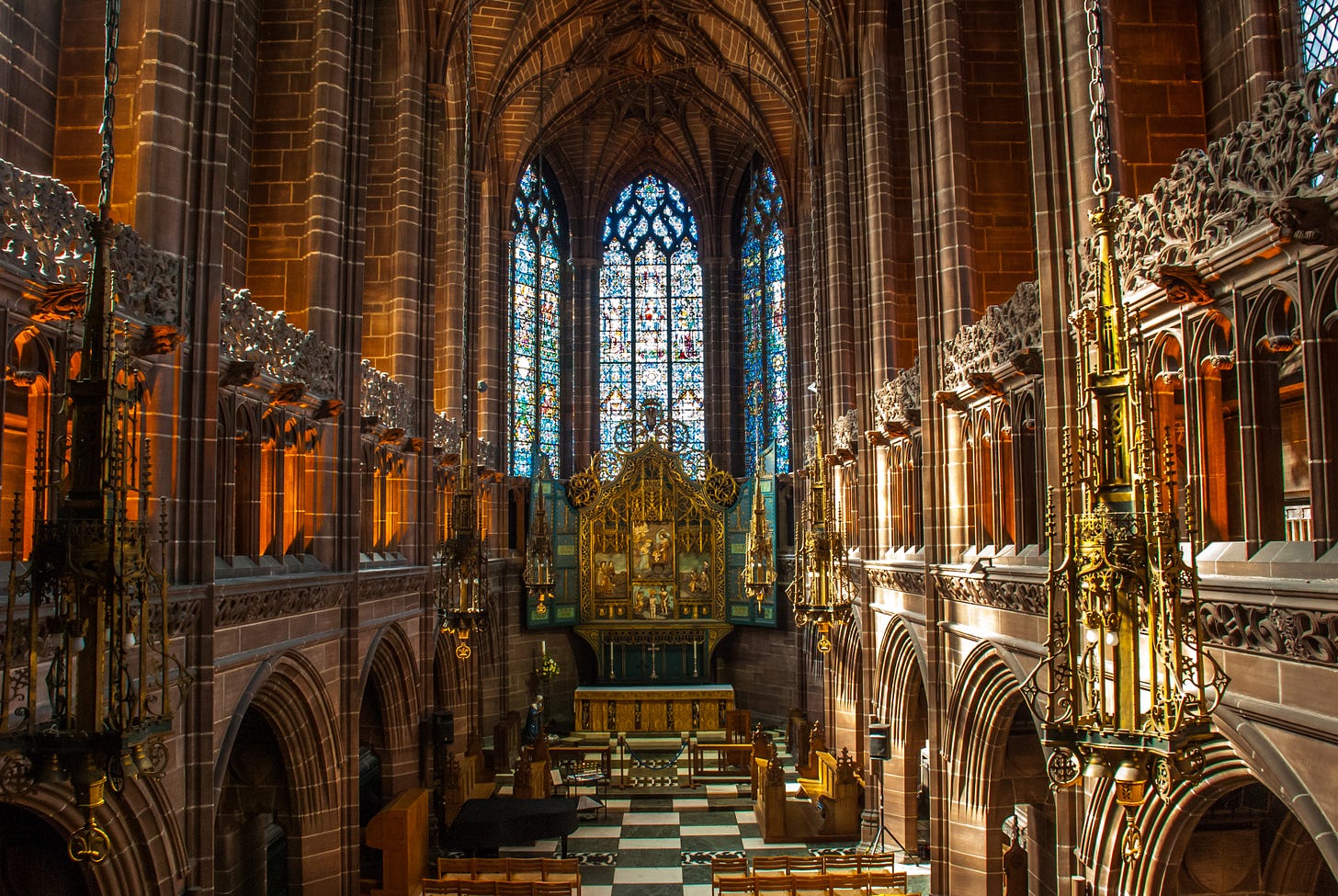
Because if they don’t, other spaces and other institutions will. Here’s a relevant personal observation: as the Architecture of Right Now has slithered its way across more and more of Boston, I’ve been disappointed to find my feelings of affection or loyalty to the city just…waning. It’s not that I want to feel less attached to the metropolis where I’ve lived for so long. It just seems to be happening. It’s literally harder for my brain to connect to the environment around me, so I feel less engaged, less invested.
It’s thinkable, even likely, that a similar detaching of loyalties from long-established institutions and places is on deck to become a mass phenomenon. Our official public culture is so adept at stymying the need for roots at every angle that many of us may find ourselves psychologically dropping out, disinvesting from identities and institutions that once genuinely engaged our hearts — even as we keep going through the motions so that we can survive economically. “Quiet quitting” may be only the beginning.
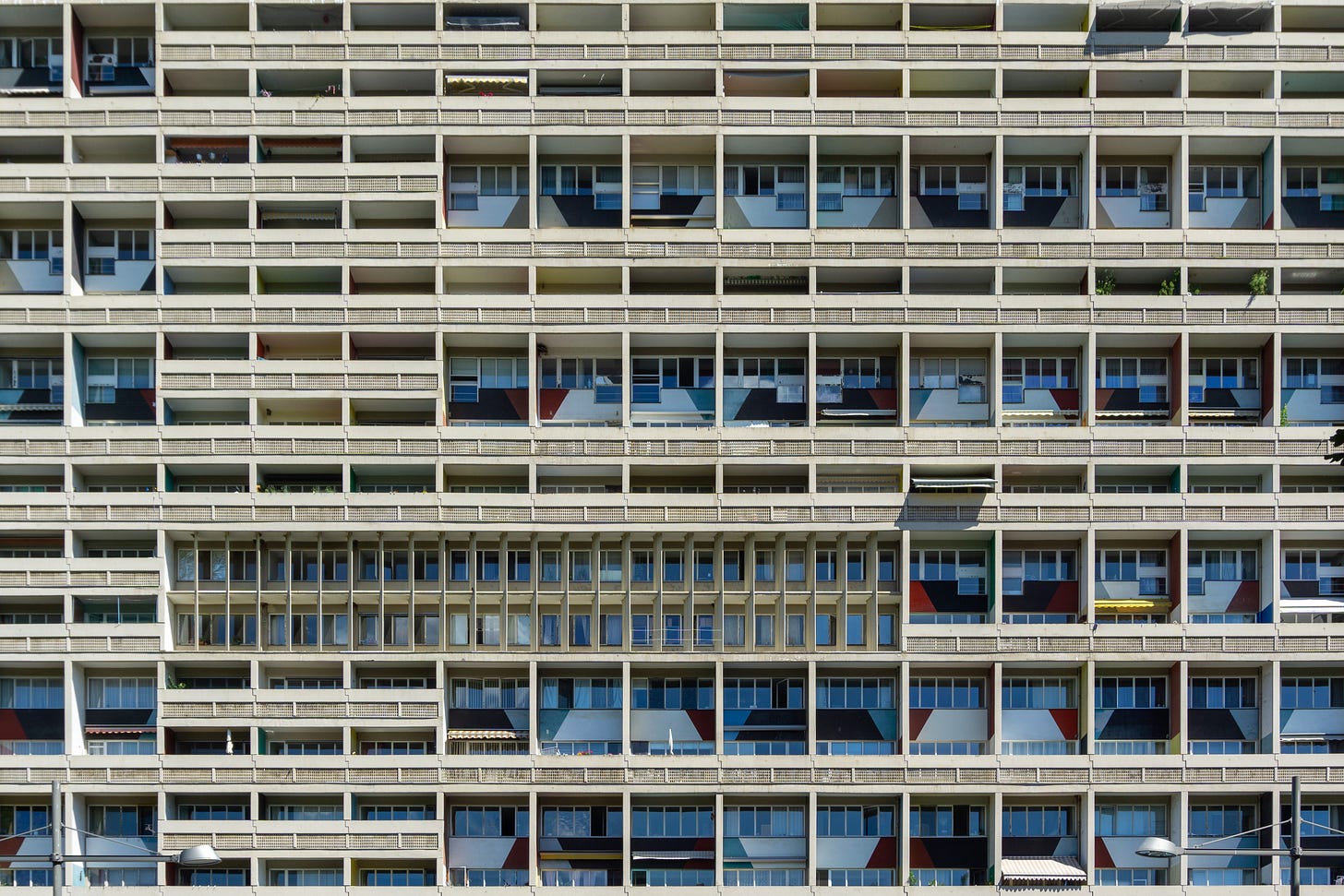
And if people turn away from neoliberal late modernity, with its sleek, flat aesthetics, many will understandably seek out environments that are rich with pattern, form, and meaning. A number will naturally find the material richness of, say, neopaganism much more appealing that the spartan minimalism of evangelical Protestantism. This is really a topic for a different essay (one I plan to write), but I think some people, hungry for a real human culture, will simply gravitate toward any environments and practices that look and feel structurally organic, where repetitive and self-similar decoration and ornament take pressure off the quest for practical utility — regardless what’s being taught in those contexts. Spiritual practices that offer sacrifice and beauty directed toward things other than God will be no match for Christian practices that look like a strip mall.
The church, and all other organic and particularistic communities, should recognize the human yearnings for roots, continuity, properly directed sacrifice, biophilia, and a principled rejection of utilitarianism. They should overcome any latent modern impulses to “reform” people out of these needs. Instead, the church should meet them. This will imply a way of life that places the spirit of Sabbath, not acquisition and work, at the center of reality. One that iconically represents eternity, in part, with recurrence.
Ultimately, the church is the proper home for the hyper-social human heart, the best-situated of all human institutions to meet our creaturely yearnings for stability, continuity, loyalty, identity, and transcendence. It’s the moral community that we need. But it can only do this by meeting us right where we are, as organic beings made in the image of God who have determinate needs for certain kinds of environments, for dynamic equilibrium, for recurring forms of patterned beauty, for symbols of continuity. By embracing these needs, the church can create that living culture. But it won’t be a purely “spiritual” culture. It will be mediated, as the postliberal theologian John Milbank likes to say. It will encompass matter.
Because that’s really what’s at stake. The art and buildings of Right Now look so sleek and flat because their designers are, somewhere behind the scramble of careerism and novelty, trying desperately to escape our four-dimensional world. They can’t handle its dreary limitations. But God made us to inhabit the muck and delight of materiality; in the words of C.S. Lewis, “God likes matter. He invented it.” As the utopian culture around us loses its bearings and, increasingly, its ability to command our loyalties, the church should be waiting, all the old tools in hand, to tangibly re-create eternity in time.
_______
* This isn’t to say that the solution is to just return to the past, revive old-school ornamentation, and pretend modernism never happened. Living systems may have looping architectures, but they can only move forward in time. The system can adapt, but not erase. And anyway, modernism in the arts has produced some remarkable fruits, particularly (in my opinion) in poetry and literature. I also happen to like midcentury modern furniture and design, whose smooth surfaces and minimalism are part of their charm. Modern architecture has been more consistently disappointing, but a future biophilic arts and architecture movement couldn’t just turn back the clock and start building, I don’t know, neo-gothic buildings without reference to the past 100 years. Somehow it would need to incorporate the 100 years of modernism and postmodernism into a coherent new sort of organic design, like a tree growing a burl around a scar.
** One conceit of the modern mind is that everything related to “folk” must be bad news because it represents backwardness, from “folk” psychology and “folk” physics (which are riddled with Baconian cognitive errors) to folk culture (which is kitschy and childish). Practically, this just means persistent, disdainful discomfort with any cultural product — music, architecture, painting, storytelling — that appeals to people’s intuitive sensibilities. The idea is that the modern project can only advance to its culmination by continuously making people uncomfortable, by jarring our intuitive tastes and preferences, challenging our default intuitions. Everything folksy is coded as a retrograde refusal to get with this program. Of course, this degradation of the humble aspects of human nature can provoke some very nasty counterreactions. It’s not coincidence that the Nazis gained power by appealing to the curdled resentments of the German “Volk.” This is another reason the church should offer what the secular world can’t, and quick.





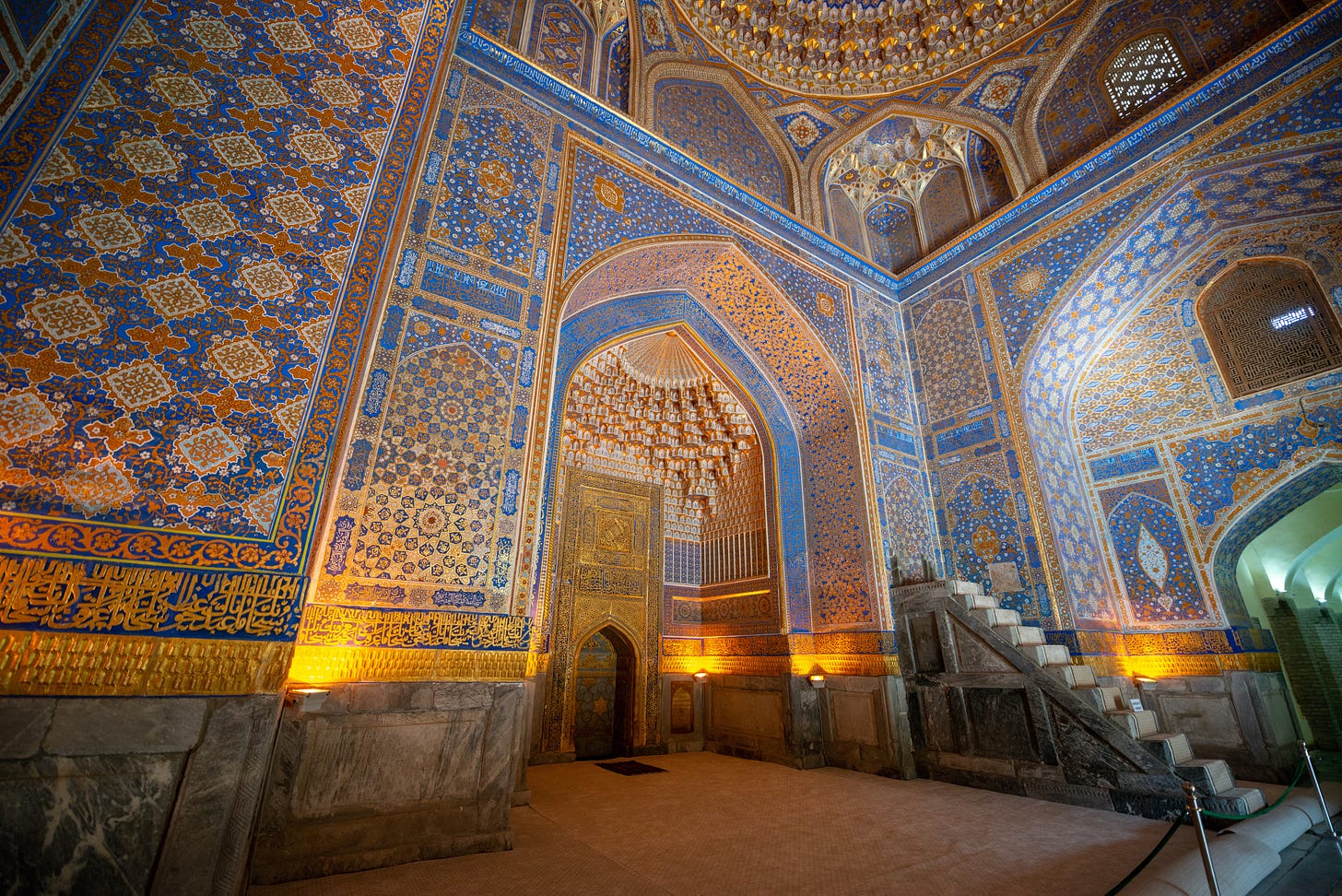
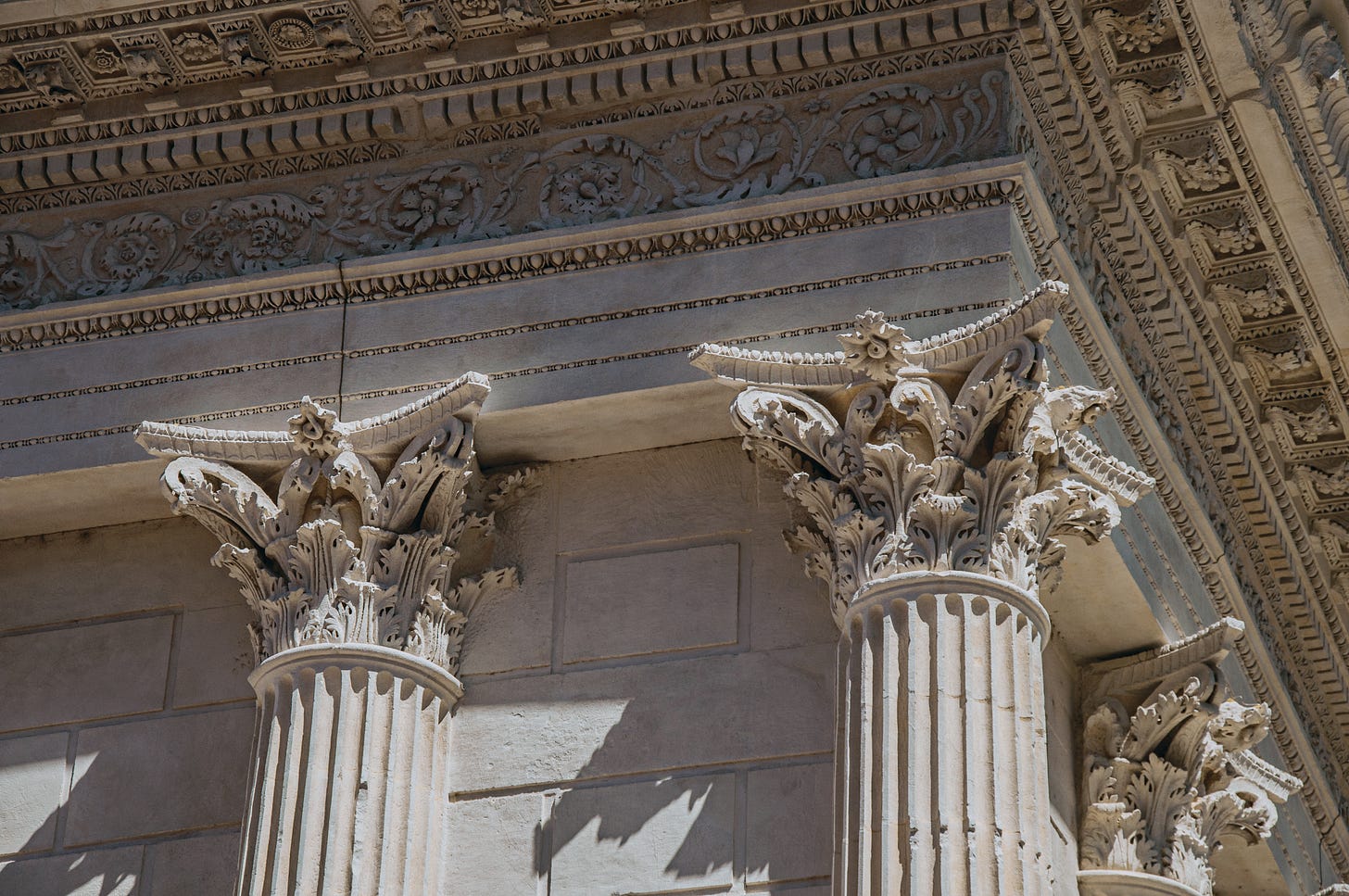

Here is a related article from Ross Douthat in the NYT. Thought you might find it interesting.
https://www.nytimes.com/2024/08/30/opinion/architecture-ideas-economics.html?smid=url-share
Probably not the point of the article, but as a biologist I feel it is important to note that the fractal pattern of natural forms is functional. Ornamentation is subtle design maximization, even if it is just ontogeny recapitulating phylogeny. Often it is an outgrowth of the organic way living creatures self assemble, a sufficiency our architecture could emulate.
See Christopher Alexander’s experiments and gorgeous books of process design.
Also, it is worth noting that SJ Gould has a whole essay where he explicitly compares the spandrels of gothic cathedrals with derived evolutionary structure. Maybe the Church has much to learn from Darwin after all!